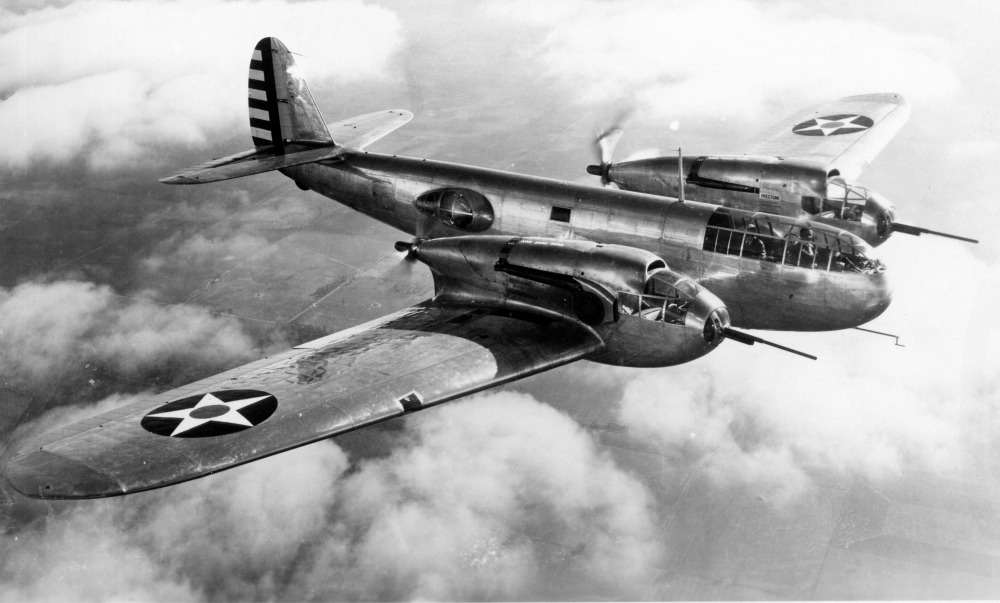
Bell YFM-1 Airacuda
The prototype XFM-1 (36-351) was flown by military pilot Lieutenant W. Benjamin "Ben" S. Kelsey, September 1, 1937. The photo shows the aircraft in its initial configuration, with carburetor air intakes in the upper part of the engine nacelles, turbochargers on the sides and propellers without hubcaps . The barrels of M4 guns, caliber 37 mm, are visible.
The FM-1 Airacuda was the first aircraft built by Bell Aircraft and the first fighter aircraft to be designed from the outset with Allison V-1710 engines. Although it was not mass-produced, it was a milestone in the development of American interceptors in the second half of the 30s and introduced Bell into the group of major military aircraft manufacturers. It features several innovative design features - turbochargers, pusher propellers, front wheel drive chassis, 37mm cannons, automatic fire control system and auxiliary power unit.
In the early 30s, two types of bomber aircraft appeared in the United States in a cantilever monoplane with an all-metal half-hull structure - the Boeing B-9 and Martin B-10. Both had retractable landing gear, and the last B-10 also had covered cockpits, a firing turret, and a bomb bay. They were a qualitative leap from the previous generation of American bombers - low-speed canvas-covered biplanes or strut-braced monoplanes with fixed landing gear and open cockpits. In addition to setting new directions in the construction of bombers, they also had a huge impact on the further development of American fighters. Due to their high speed and rugged construction, they proved to be a big problem for the then-prime fighter aircraft of the United States Air Force (USAAC), rendering them obsolete almost overnight. During the exercises, it turned out that the Curtiss P-6E and Boeing P-12E biplanes could not catch up with them in practice, and if they caught up, they were armed with two 7,62 mm machine guns or one caliber. 7,62 mm and one 12,7 mm caliber could be too weak to shoot them down. Things were not much better with the Boeing P-26A monoplane, which was clearly faster than the P-6E and P-12E, but just as poorly armed.
A full-size wooden functional mock-up of the XFM-1 at Bell Aircraft's facility in Buffalo, New York. The XFM-1 (factory designation Model 1) was based on a preliminary design developed by designer Robert "Bob" J. Woods in the summer of 1934.
Of course, in the real world, USAAC fighters did not have to fight the B-9 and B-10, but the appearance of such bombers in the air forces of the countries with which the United States of America was only a matter of time. States may someday go to war. In this situation, in 1934, both the engineers of the material department of the Air Corps at Wright Field, Ohio, and the designers of various aircraft manufacturers began to design new fighters with higher performance and more powerful weapons. The greatest hopes for a radical increase in performance were associated with the Allison V-12 1710-cylinder in-line liquid-cooled engine. The V-1710-C1 version, designed specifically for the USAAC, reached 1933 hp in 750. on the dynamometer, and the goal of the designers was to achieve a continuous power of 1000 hp. for several years. In turn, large-caliber guns - 25 or even 37 mm - were considered the most effective weapons to combat metal bombers. Although they had a low rate of fire, a few rounds were enough to successfully hit a target.
One of the designers who took on this challenge was Robert "Bob" J. Woods, then with the Consolidated Aircraft Corporation in Buffalo, New York. His work was, among other things, single-engine, monoplane, two-seat fighters Ya1P-25, R-30 and R-30A (PB-2A). The latter was the first American production fighter in the cantilever monoplane system with an all-metal half-hull design, with retractable landing gear, covered cockpits and a turbocharged engine. The R-30A was a significant improvement over the R-26A, but due to its weak armament, it was also unsuited to combat modern bombers.
In the summer of 1934, Woods, on his own initiative, developed a preliminary design for a specialized bomber-destroyer. It was a large twin-engine medium wing with a wingspan of 27,43 m, a length of 17,32 m, a lift area of 120,77 m2, an unladen weight of 5262 kg and a takeoff weight of 10 kg. So it was much larger and heavier than the B-433 bomber! It had a retractable landing gear with a tail wheel and double vertical tail. The power plant consisted of two V-10 engines with an estimated power of 1710 × 2 hp, placed in engine nacelles on the wings and driving three-blade pusher propellers. In front of the gondola were glazed firing positions, each of which had a manually operated 1100 mm movable cannon. To combat the fighters, six 37 or 7,62-mm mobile machine guns were used - two in turrets on the sides of the forward fuselage and four in the windows on the sides, above and below the middle part of the fuselage. The crew of five consisted of a pilot, a commander (who also served as co-pilot and navigator), a radio operator gunner and two airborne gunners.